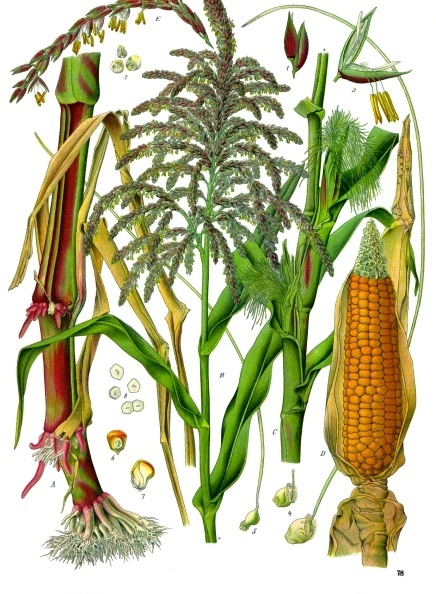Maize was the first New World crop to capture European interest. Columbus’s description of it was reported in a letter dated 13 Nov. 1493 from Peter Martyr d’Anghiera, a historian of the Spanish court, to the vice chancellor of the papal court, Cardinal Ascanio Sforza: “The islanders also easily make bread with a kind of millet, similar to that which exist plenteously amongst the Milanese and Andalusians. The millet is a little more than a palm in length, ending in a point, and is about the thickness of the upper part of a man’s arm. The grains are about the form and size of peas. While they are growing, they are white, but become black when ripe. When ground they are whiter than snow. This kind of grain is called maiz” (Janick 2013 – pg 406).
After the return of some ships from Columbus’ second voyage on 3 May 1494, Peter Martyr delivered seeds to Cardinal Sforza that included maize. From there, the seeds were taken to the Vatican, where the earliest European pictures of maize were painted in frescoes. Giovanni da Udina between 1517 and 1519 included maize in his decorations for the Vatican loggia designed by Raphael. These early images included long and short ear types and demonstrated the genetic diversity of the early introductions from the New World.
The enormously powerful merchant and banker Agostino Chigi (1466–1520) was a pivotal figure in the further dissemination of maize across the Mediterranean Basin. He had a garden of rare plants (viridarium) in Rome, was well known to Cardinal Sforza and Pope Alexander VI, was influential in the affairs of the Vatican and the Republic of Venice, and was directly involved in trade between Venice and Turkey through his monopolies concerning alum and cereals (Janick and Caneva, 2005).
The first maize cultivation in Germany was documented in 1539 by the famous herbalist Hieronymus Bock. Since maize from the Caribbean was not likely well adapted to the cooler regions of northern Europe, these seed must have come from temperate North America (Tenaillon and Charcosset, 2011). They could have been imported by John Cabot who visited North America in 1497 or Jacques Cartier who made his first voyage to the eastern seaboard in 1534. Few details exist of either of these trips, but it is known that Cartier brought back botanical specimens in what has been called the ‘Cartierian exchange’ (Dickenson, 2008).
By the mid-16th century, maize was an important crop in Asia Minor and across the Balkans, becoming a staple of the growing Ottoman armies. Maize was well established in Germany and the Alpine regions of Italy by 1570 and in the 1600s became a popular crop in northern Spain and southwestern France.
Maize was being grown by 1571 on the island of São Tomé and had spread to West Central Africa in the second half of the sixteenth century (Freitas, 2019). There is evidence of maize being grown in the Kongo as the “grain of Portugal” by 1591 and northern Angola in 1600. By 1630, a Jesuit farm in Luanda, was not only producing “war flour” of wheat to feed the Portuguese soldiers engaged in colonial wars, but also maize, potatoes, pineapples, and papayas from Brazil. By 1600 it had become established as a staple at least six hundred miles inland, and steadily advanced along the Congo, reaching the Lake Tanganyika about 1830.
Maize probably also arrived in Eastern Africa in the late 1500s, although it didn’t become established until the mid-sixteenth century (Freitas, 2019). There is an account of Portuguese settlers on Zanzibar and Pemba growing maize in 1643 to supply the Portuguese garrison at Mombasa. There are also reports of it in Madagascar in 1717 and in Mozambique in 1750. By the end of the nineteenth century, maize was widespread across eastern Africa.
The Spanish or the Portuguese introduced maize into the Indonesian Archipelago in the sixteenth century and by the late seventeenth century, it was a main staple crop in Eastern Indonesia (Boomgaard, 2003). By 1940, it claimed a quarter of all arable lands in Java in Western Indonesia.
Maize also found its way to China within decades of its discovery by Europeans. It was introduced to China in the 1500s from the Americas by three routes. The first was the Silk Road winding across Central Asia and the Pamir Mountains into Gansu, a province in northwest China. The second was through India and Myanmar into the southwestern province of Yunnan; and the third, was by sea into the coastal province of Fujian in the south, brought in by Portuguese traders.
The Hakka people of China were instrumental in spreading maize and sweet potato in China (Mann, 2011). At the end of the 16th century, as the population of China began to burgeon, the Hakka people were forced to migrate into the barren hills and mountains that had not supported traditional food production. The Hakka employed slash-and-burn agriculture, moving constantly northward as they sought new virgin lands. They ultimately came to reside in a 1,500-mile stretch of China’s southeast coastline from the hills of Fujian to the cliffs around the Huang He in the northwest.
Illustration: Zea mays, corn (maize). Kohlers Medicinal Plants, 1887, Plate 282
Bibliography
Dickenson, V. (2008). Cartier, Champlain, and the fruits of the New World: Botanical exchange in the 16th and 17th Centuries. Scientia Canadensis, 31(1-2)
Hancock, J. F. (2022) World agriculture before and after 1492: Legacy of the Columbian Exchange. Springer
Janick, J. (2013) Development of new world crops by indigenous Americans. HortScience 48 (4): 406-412.
Janick, J. and Caneva, G. (2005). The first images of maize in Europe. Maydica, 50(1): 71-80.
Mann, C.C. (2011) 1493: Uncovering the New World Columbus created. Vintage Books, New York
